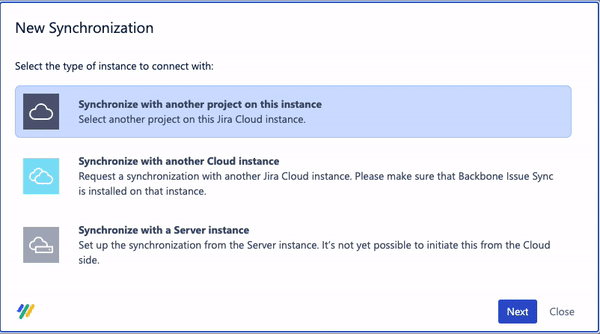Get started
Thanks for choosing Backbone Issue Sync for Jira. Backbone helps you simplify collaboration on projects, internally or across organizations, by synchronizing Jira issues in real-time.
This guide will illustrate the steps required to get started with Backbone on Jira Cloud.
Watch the video
To learn more about what Backbone can do for you, watch the Get Started video that introduces Backbone’s features.
1: Finding Backbone in Jira
After installing Backbone Issue Sync for Jira from the Atlassian Marketplace, you can find Backbone in the Jira sidebar of a project under the “Apps” tab.
To create your first project synchronization, follow these steps:
Go to Project settings > Apps > Issue Synchronization.
Click New Synchronization.
As illustrated below, Backbone allows you to create a synchronization:
With another project in the same instance.
With another Cloud instance.

2: Synchronizing Projects Using Backbone
There are two separate options when syncing Jira projects using Backbone. Please choose the section that applies to your use case.
Synchronizing projects on the same Jira instance.
Synchronizing projects on a separate Jira instance.
3: Configure Synchronization Settings
After establishing a connection between two Jira projects, you can now select the exact type of Jira data you want to synchronize. The following steps will guide you on how to successfully set up a sync.
Issue Type Mapping:
To start editing the synchronization, click Edit Configuration.
Open the Issue Types tab and click Start with simple mappings.
Select the issue types you want to map across Project A and Project B.
a. In this example, we will select the issue type Task.You can use the drop down box and choose to synchronize the issue types either in both directions between Project A and Project B or in one direction.
Click Create to save the issue type mapping.
Field Mapping:
- Navigate to the Fields - Mappings tab > + Field Mapping.
- Select the fields you want to synchronize. In this example, we will select Summary and Description.
- You can use the drop down box to synchronize issue fields either in one or both directions.
- Click Create to save the fields configuration.
Comments Mapping:
Navigate to the Comments tab.
Use the drop down box to choose between uni-directional or bi-directional comment mapping.
Click Enriched mapping to get the complete information about the reporter and comment date and time.
Click Publish Draft > Start Synchronization.
Well done! You've configured your first Backbone synchronization. Now, all issues with type Task will be synchronized between Projects A and B.
The fields Summary and Description fields will be synchronized between those issues along with any comments.
4: Using the Synchronization
Now for the fun part: let's use Backbone to test the synchronization by creating an issue type Task in Project B and testing whether the issue is automatically synchronized to Project A.
Create a new issue with type Task in Project B, and enter some text in the Summary and Description fields.
Open Project A. You can see that the issue has now been synchronized.
Open the synchronized issue in Project A and add a comment.
Go back to the issue in Project B and open the synced Task. The comment can now be seen as well.
Easy-peasy! You have successfully created and tested your first synchronization.
Next steps:
Now, you can try out more configuration options, such as different issue/field types, or comments and attachments.
